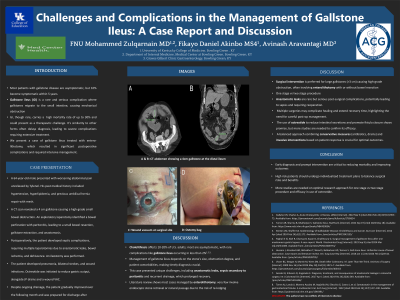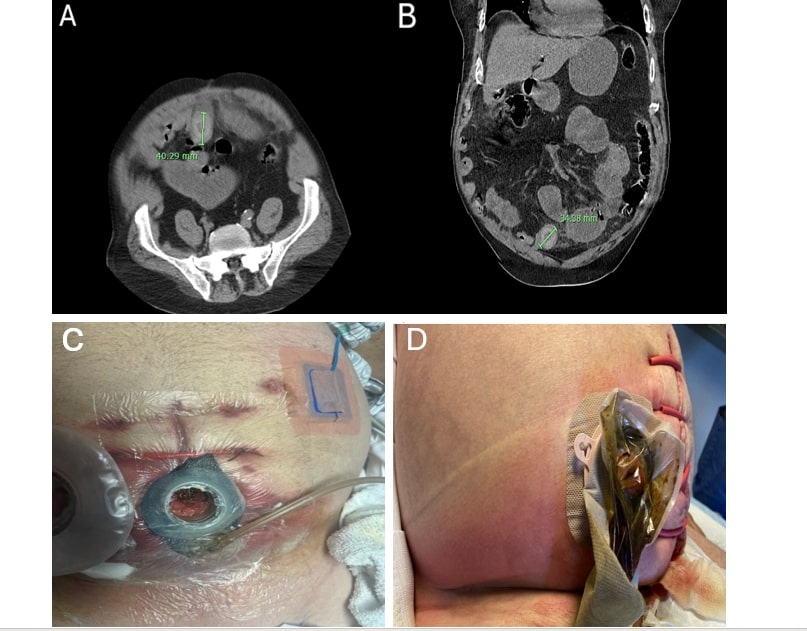Tuesday Poster Session
Category: Biliary/Pancreas
P3571 - Challenges and Complications in the Management of Gallstone Ileus
Tuesday, October 29, 2024
10:30 AM - 4:00 PM ET
Location: Exhibit Hall E

Has Audio
.jpg)
Fnu Mohammed Zulqarnain, MBBS
University of Kentucky College of Medicine
Bowling Green, KY
Presenting Author(s)
Fnu Mohammed Zulqarnain, MBBS1, Fikayo D. Akinbo, MD1, Avinash Aravantagi, MBBS2
1University of Kentucky College of Medicine, Bowling Green, KY; 2Graves Gilbert, Bowling Green, KY
Introduction: Gallstone ileus (GSI), a rare yet serious complication resulting from Gallstone disease (GSD), caused by a gallstone passing through a fistula between the gallbladder and the duodenum causing obstruction. GSI can mimic other types of bowel obstruction, making diagnosis challenging. We present a case of GSI treated with Enterolithotomy (EL), which was associated with multiple postoperative complications
Case Description/Methods: 64 year old male with a history of Obesity, Dyslipidemia, and umbilical hernia repair presented with abdominal pain. CT scan revealed a 4 cm GS causing small bowel obstruction. Ex. laparotomy revealed a perforation with peritonitis. GS was extracted with small bowel resection and anastomosis was performed. Postoperatively, the patient received antibiotics and supportive care. Recurrent anastomotic leaks led to multiple ex. laparotomies, and showed ileal defect likely due to ischemia and dehiscence prompting further resection and ileostomy. Other complications were stroke, sepsis and site cellulitis. Continued drainage necessitated placement of drains with wound VAC. Conservative measures, including octreotide to reduce gastric output, were employed. The patient showed gradual improvement, enabling minimal enteral feeding with stable cardiorespiratory status
Discussion: GSI is rare, affecting less than 0.5% of all patients with GSD. Management depends on the stone's size, obstruction severity, and comorbidities, making timely diagnosis crucial for intervention. Our case highlights the complex management of GSI. Our review found most cases involved EL, with few using endoscopic routes. Most patients had EL with few complications, contrasting with our case's unique anastomotic leaks. Conservative measures are preferred, but surgery is indicated for high-grade obstructions, typically EL and possibly bowel resection. Bowel resection increases mortality, especially in emergencies, due to complications like peritonitis, leaks, or sepsis. Effective management post-EL is crucial, as anastomotic leaks can lead to severe complications. Postoperative complications in our patient were stroke, feculent peritonitis, and sepsis requiring a balance of conservative and invasive interventions. Timely diagnosis and management of GSI are vital. EL for GSI carries risks, but skilled post-operative care is essential for recovery. Combining conservative measures and invasive interventions, guided by patient response, is crucial for optimal outcomes and minimizing complications

Disclosures:
Fnu Mohammed Zulqarnain, MBBS1, Fikayo D. Akinbo, MD1, Avinash Aravantagi, MBBS2. P3571 - Challenges and Complications in the Management of Gallstone Ileus, ACG 2024 Annual Scientific Meeting Abstracts. Philadelphia, PA: American College of Gastroenterology.
1University of Kentucky College of Medicine, Bowling Green, KY; 2Graves Gilbert, Bowling Green, KY
Introduction: Gallstone ileus (GSI), a rare yet serious complication resulting from Gallstone disease (GSD), caused by a gallstone passing through a fistula between the gallbladder and the duodenum causing obstruction. GSI can mimic other types of bowel obstruction, making diagnosis challenging. We present a case of GSI treated with Enterolithotomy (EL), which was associated with multiple postoperative complications
Case Description/Methods: 64 year old male with a history of Obesity, Dyslipidemia, and umbilical hernia repair presented with abdominal pain. CT scan revealed a 4 cm GS causing small bowel obstruction. Ex. laparotomy revealed a perforation with peritonitis. GS was extracted with small bowel resection and anastomosis was performed. Postoperatively, the patient received antibiotics and supportive care. Recurrent anastomotic leaks led to multiple ex. laparotomies, and showed ileal defect likely due to ischemia and dehiscence prompting further resection and ileostomy. Other complications were stroke, sepsis and site cellulitis. Continued drainage necessitated placement of drains with wound VAC. Conservative measures, including octreotide to reduce gastric output, were employed. The patient showed gradual improvement, enabling minimal enteral feeding with stable cardiorespiratory status
Discussion: GSI is rare, affecting less than 0.5% of all patients with GSD. Management depends on the stone's size, obstruction severity, and comorbidities, making timely diagnosis crucial for intervention. Our case highlights the complex management of GSI. Our review found most cases involved EL, with few using endoscopic routes. Most patients had EL with few complications, contrasting with our case's unique anastomotic leaks. Conservative measures are preferred, but surgery is indicated for high-grade obstructions, typically EL and possibly bowel resection. Bowel resection increases mortality, especially in emergencies, due to complications like peritonitis, leaks, or sepsis. Effective management post-EL is crucial, as anastomotic leaks can lead to severe complications. Postoperative complications in our patient were stroke, feculent peritonitis, and sepsis requiring a balance of conservative and invasive interventions. Timely diagnosis and management of GSI are vital. EL for GSI carries risks, but skilled post-operative care is essential for recovery. Combining conservative measures and invasive interventions, guided by patient response, is crucial for optimal outcomes and minimizing complications

Figure: A & B: CT abdomen pelvis wo contrast: Shows gallstone measuring 4 cm in size
C: Wound VAC
D: Ileostomy
C: Wound VAC
D: Ileostomy
Disclosures:
Fnu Mohammed Zulqarnain indicated no relevant financial relationships.
Fikayo Akinbo indicated no relevant financial relationships.
Avinash Aravantagi indicated no relevant financial relationships.
Fnu Mohammed Zulqarnain, MBBS1, Fikayo D. Akinbo, MD1, Avinash Aravantagi, MBBS2. P3571 - Challenges and Complications in the Management of Gallstone Ileus, ACG 2024 Annual Scientific Meeting Abstracts. Philadelphia, PA: American College of Gastroenterology.
